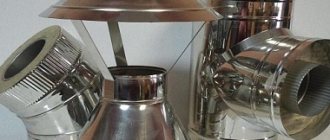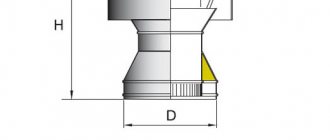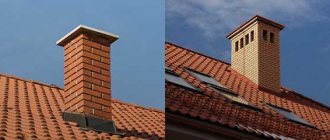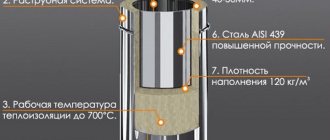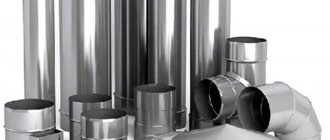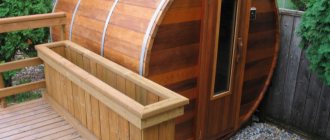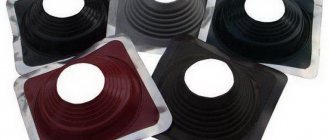If there is not enough draft, the operation of the stove will not be complete, anyone who has an idea about chimney pipes knows this.
In order to fully ensure normal draft, it is necessary that the air flow be sufficient and the gas outlet be carried out on time; for this, a deflector is needed on the chimney. Properly designed and high-quality smoke exhaust devices ensure the correct and trouble-free operation of any stove. The efficiency of the stove and ensuring normal draft is influenced by such factors as: changes in climatic conditions (wind, snowstorm, various types of precipitation), the presence of debris, which often falls directly into the chimney and clogs it.
To ensure the normal operation of a pipe in which there is no pressurization, a high-quality chimney is needed, which is able to ensure the timely and regular removal of combustion products. If the option under consideration is not possible for some reason, the presence of such a mechanism as a chimney deflector is an excellent assistant in this matter. Let's take a closer look at the topic - how to make a chimney deflector with your own hands: instructions and drawings.
What causes a chimney pipe to smoke?
A deflector is a device on a chimney pipe, the use of which creates obstacles in the path of air flow created by the wind. To put it simply, this is a very simple, but at the same time highly effective device for protecting the chimney from various types of litter, precipitation, etc.
Experts say that to increase the efficiency of the stove by 25%, it is enough to install a deflector on the smoke exhaust pipe. In order for it to work efficiently, correctly and without problems, it is necessary that the chimney itself be installed as expected (the required height of the structure, its location, the correct cross-section, etc.).
It often happens that the chimney pipe begins to smoke, and in order to eliminate this problem, you first need to find out what are the reasons for this behavior of the structure. So, the first reason is the increased speed and power of air flows due to strong, gusty winds. In this case, the smoke is simply “not allowed” to come out, crushing it with a strong flow entering the pipe.
The second reason is the incorrectly selected chimney diameter (the importance of this factor was previously mentioned). If the diameter is too small, the smoke will not have enough space to exit the pipe normally.
Smoke will be a regular process even if the chimney itself is not located correctly on the roof (as it turns out, even such seemingly insignificant details can affect the efficiency of the structure).
Why do you need a deflector?
The purpose of the device is obvious - the product increases the draft of the stove and at the same time protects the heating installation from snow, rain and dirt. Without a deflector, the wind blows out the stream of escaping smoke, causing an obstacle or even resistance. The heat generator's draft drops.
Experienced data suggests that the presence of the described device on the pipe of a private house provides an increase in the efficiency of the heating installation. The amount of such winnings is up to 20%.
Types of deflectors for the chimney pipe
After we have figured out the reasons, we can begin to solve the existing problem by analyzing the available types.
By design, there are several types of the device in question:
- “Volper” (has a fairly simple design and round shape)
- deflector for the Grigorovich chimney (looks like a gazebo)
- spherical (the name speaks for itself)
- N-type deflector
- "Shenard" (available in star shape)
- TsAGI
- Double
- "Deflector-Weather Vane"
Causes of smoke
The principle of operation of the deflector as a gas exhaust structure
Smoking in a furnace is most often explained by the so-called “overturning of draft”, which occurs due to a long period of inactivity of the heating installation. This leads to cooling of the internal spaces and a decrease in the pressure gradient. As a result, the air flow in the pipe changes its direction and rushes not outward, but towards the heat source.
This phenomenon has nothing to do with the outside temperature and can occur in hot weather and cold weather. To eliminate the effect of backdraft in the chimney, you will need to increase the temperature in the outlet pipe. One of the ways this can be achieved is by installing a high-quality chimney deflector.
Drawings, dimensions and parameters
Each of the available types has its own parameters and manufacturing methods. In order to understand the designs and parameters of such a device, we will consider several of them, and also find out how to make a chimney deflector with your own hands using drawings.
Deflector for the Grigorovich chimney pipe: this type is characterized by its simple design and high efficiency. The height of the device in question is 1.6 d, the width of the manufactured cap should not exceed 1.9 d. During manufacturing, it is also worth paying attention to the carefully selected width of the diffuser; in this case, the parameter in question will be equal to 1.3 d (it is also worth noting that the d value means the selected diameter of the chimney, or more precisely, its channel).
TsAGI deflector: in the form under consideration, the correctly selected size of the diffuser (more precisely, its wide part) plays an important role. This parameter is equal to 1.25 d, since it is necessary to make a ring here, you need to know its dimensions (height 1.3 d, diameter at this height should be equal to 2.5 d). Since this design contains a part in the form of an umbrella, its parameters must also be calculated accurately - the width of the part is 1.8 d.
What is a weather vane and its types?
The weather vane is an antique decorative element and also covers the chimney pipe, protecting it from the penetration of precipitation: rain and snow. A weather vane attached to the chimney will give the roof an aesthetically pleasing and complete appearance. It is a metal structure consisting of a flag and a counterweight.
A weather vane mounted on the chimney is the finishing touch. Dome on the chimney - protection, weather vane - decor
The principle of operation is simple: the counterweight is directed in the direction from which wind currents are blowing, and the flag indicates their direction. The tradition of installing a weather vane came from Europe. The flag is now a real decorative element. It can be made in the form of a figurine: a bird, an animal, a man. In Rus', the most popular figurine was the one depicting a rooster, since a popular legend said that its voice was capable of driving away demons. Nowadays, the image of a ship, which is considered a symbol of a happy and successful life, is relevant. The lion, in turn, is a symbol of enormous vitality, nobility, justice, as well as the desire to move forward.
Weathervane-arrow - you are probably already familiar with it
Main types of weather vanes:
- indicating the direction of the wind. It is widely used in meteorology. Despite the availability of many modern devices, weather vanes are still in demand. They occupy a special place in coastal cities, since the functioning of ports directly depends on the direction of the wind. The response of the weather vane is noticeable even at the slightest appearance of wind flow and is detected even when other devices are still powerless;
- Wilda. This is a more modern weather vane model, capable of determining not only the direction, but also the strength of the wind. This model has a plate mounted vertically. The angle of inclination shows strength.
We also recommend studying this topic: Do-it-yourself chimney deflector: drawings and diagrams
The chimney vane has a simple design and can be made with your own hands.
Advice! The process is simple and will not be difficult, the main thing is to strictly follow the instructions and focus on the drawings.
Readers found these materials useful:
- Do-it-yourself ceramic chimney installation, tips and tricks
- We install the heat exchanger on the chimney ourselves
Operating principle and design of the chimney deflector
Before you start making a deflector for a chimney with your own hands, you need, first of all, to know its structure, drawings and understand the principle of its operation. So, such devices, despite their multiple varieties, consist of three main parts: a diffuser, a cylinder and, directly, a cap. We should not forget about the seemingly insignificant, but in fact, important component of the deflector - ring-type rebounds.
Despite the variety of types of chimney deflectors, the principle of their operation is identical:
- The movement of air flows that enter the chimney is hindered by the walls of the cylinder, which is located in the upper part of the deflector. It turns out that the air flows hit it and a portion of the air mass from the jet moves up the cylinder itself, taking with it the smoke that comes out of the chimney.
- As a result, it turns out that the speed of smoke exiting the chimney becomes greater, while the draft increases significantly, which in turn increases the efficiency of the chimney itself.
- If there is a deflector, it does not matter at all what the speed of the air flow from the outside is, and from which direction the wind blows, because there are special gaps in the cylinder that suck the smoke into the air.
Definition of a weather vane and its varieties
A weather vane is a metal device that consists of a flag and a counterweight. Its use was first recorded in Europe. The design is an original decoration of the roof and a protective element against precipitation and birds getting into the chimney. A weather vane fixed to the chimney aesthetically complements the roof, giving it completeness.
The simple principle of operation is as follows: wind flows act on the counterweight, directing it in the direction of the air flow, and the flag indicates the direction. It is the flag that has a decorative role. Its execution can be in the form of various figures: a crane, a cat, an animal or a person. Even from Old Russian fairy tales, we are familiar with the tower with the figurine of a rooster, because in ancient Rus' there was a belief that it was the voice of this bird that drove away evil spirits. Today, a figurine of a ship with sails, considered a symbol of happiness and good luck, is relevant. The image of a lion is marked by the symbolism of the enormous potential of the owner’s strength, justice and the desire to move forward.
There are the following types of weather vanes:
- indicating wind currents. This type is relevant for use at meteorological stations. Even despite the large amount of modern equipment, weather vanes are still used. They play a major role in coastal cities, where the direction of the wind determines the performance of ports. The sensitivity of the weather vane is very high and even at a low level of wind flow, the device will detect it, at a time when modern equipment does not yet work.
- Wilda. A modern type of weather vane that determines both the direction and strength of the wind flow. This device is equipped with a vertical plate, the angle of inclination of which indicates the force. from which the wind blows.
Tip! To make a weather vane yourself, you will need to strictly follow the step-by-step instructions, focusing on the drawing diagram.
Features of this design
If the wind blows from below, some turbulence is formed under the structure’s hood, which causes the smoke output to slow down (this is a minor, but still a drawback of the products in question). But here there is a way out, namely a solution to this problem - installing an inverted cone under the umbrella of the device itself.
Chimney deflectors are quite simple devices in design and operating principle, but at the same time, their efficiency can undoubtedly be called high. Each device, and deflectors are no exception, has certain disadvantages, but if we conduct a general analysis of all the available characteristics and capabilities of this device, then the pros and cons clearly have advantages over the cons and disadvantages.
Installation of a deflector on a chimney pipe
Correct manufacturing of such a design is not the key to the success of its operation, because installation, which is the final stage for using the device, plays an equally important role.
The deflector is installed on the chimney, and it will be easy to install both a self-made structure and one purchased in a store. Since the device consists of many parts, before climbing onto the roof and proceeding with installation, it must be assembled into a single whole. Making a deflector, the instructions and drawings of which will be discussed below, is quite simple to install, and in this case no additional skills and knowledge are needed.
The installation method will depend on the chimney pipe itself on which the deflector will be located. Most often, for a strong attachment it is enough to use a couple of drill holes and a clamp (you cannot do without drilling holes in the chimney itself). If the material with which the roof is covered is flammable, then you will have to additionally purchase a spark arrester, which must be installed on the deflector.
Rotary turbines for the exhaust system
These are the most popular devices for this purpose. Compared to other designs, their productivity is 20-25% higher.
The advantage of using them is that they do not use any energy source during operation.
Always rotating in one direction under the influence of the wind, the turbine head creates a vacuum inside the ventilation pipe, which promotes the active process of air circulation.
In addition, elegantly made of steel, it also serves the function of protecting the pipe mouth from atmospheric precipitation.
The head part is made of aluminum strips up to 0.5 millimeters thick, and the base is made of steel sheet painted in RAL colors.
Rotary turbines can be used on round, square or rectangular ducts or chimneys. In addition, they can be used for chimney systems.
Drawings on how to make a deflector for a chimney with your own hands
The sequence of actions during the manufacture of the device will be as follows:
- We make a drawing of all the parts on paper (and their hollow size), cut them out and connect them together.
- If all the parameters match on the paper model, we do the same on the metal sheet.
- A diffuser shape is cut out of a piece of metal and rolled into a cylinder.
- To connect all the parts of the deflector, you need to carefully drill holes in the elements and use bolts or special rivets to create a single structure.
- Then the cap is made, the strips are made, and all the separately made parts are joined together.
What is a chimney deflector video review
There is nothing complicated in the process of making a deflector for a pipe with your own hands, the main thing is to follow the assembly rules and do not forget about the correct selection of all design parameters.
Step-by-step instructions for making a weather vane
There are many options for making a chimney weather vane with your own hands. The drawings will help with this.
Original weather vane
A chimney deflector made of stainless steel and bronze for a more durable service.
The material for the manufacture of such a model will be stainless steel or copper, the thickness of which is 1 millimeter. Both of these metals have good anti-corrosion properties, they are lightweight and durable.
Advice! If copper is used, the service life of the weather vane increases, but it should be taken into account that this metal is more expensive.
The process of making a weather vane with your own hands:
Step 1. Select the mass and dimensions of the future model. Drawing will help
Calculation of the mass of the future weather vane based on the parameters of the pipe diameter, steel thickness, weight of the axle, bushing and bearings.
Step 2. Parts for the weather vane should be cut from the selected steel.
Using metal scissors, parts are cut out of stainless steel for the future weather vane-dome for the chimney
Step 3. We assemble the structure as shown in the figure.
The design of the weather vane and the schematic principle of assembly. Help for those who want to create it themselves
Step 4. The weather vane is ready.
The final version of the weather vane. Blue arrow - air intake, red smoke exit
Installation of such a weather vane is carried out on top of the chimney. It not only serves as decoration and gives the chimney duct a finishing look, but also prevents the occurrence of reverse draft.
Advice! Wind, temperature changes, and precipitation are factors that destroy the chimney pipe. Installing a weather vane is necessary to increase its service life.
